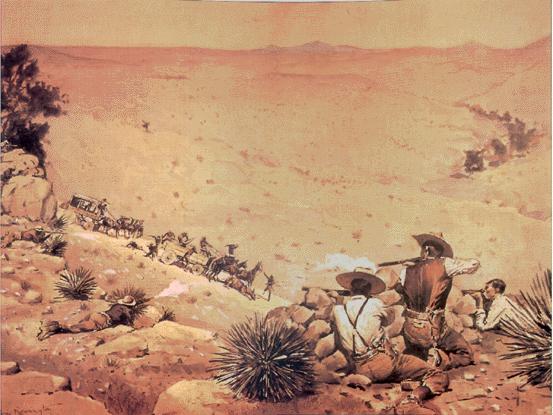
Reproduced courtesy of Bank One Arizona.
Link to Presentation by Larry Upton, Arizona Historical Society, October, 1999
"The great Wham Paymaster Robbery has almost disappeared from the public mind, but it remains one of Arizona's great mysteries. Shortly after midday on May 11, 1889, a band of robbers ambushed U.S. army Paymaster Maj. Joseph Washington Wham (pronounced Wham, as in bomb) and his military escort along the Fort Grant-Fort Thomas Road about fifteen miles west of Pima in the Gila River Valley. Following a hard-fought gun battle, the bandits made off with more than $28,000 in gold and silver coins. The daring robbery and the subsequent trail of suspects in the heist created a sensation throughout the Southwest. Questions of guilt and innocence, and of what happened to the money, still linger more than a century later."
The above quotation is the first paragraph of an article "Who Robbed Major Wham?", The Journal of Arizona History, Volume 38, Number 2, page 99, Summer, 1997, written by Larry T. Upton and Larry D. Ball.
Major Joseph Wham and group of soldiers, carrying a military payroll of $29,000, were attacked by a dozen outlaws near Fort Thomas, Arizona Territory. After wounding more then half the soldiers and driving off the rest, the outlaws simply walked away with the entire payroll. A posse of lawmen rounded up various suspects who were later charged with the sensational robbery. Most of these suspects were Mormons with political connections and the accused men were defended by the famed lawyer Marcus Aurelius Smith. Major Wham and his men were unable to identify any of the dozen defendants in court and they were all acquitted. It was widely claimed that political pressure from the acting governor allowed the thieves to go free.
In 1889, black infantrymen of the 24th and cavalrymen of the 10th serving with a detachment escorting Major Joseph W. Wham, paymaster, U.S. Army, in an encounter with a band of robbers, by whom the party was attacked between Forts Grant and Thomas, Arizona. In reporting the robbery to the Secretary of War, Major Wham described how his "party was ambushed and fired into by a number of armed brigands, since estimated by U.S. Marshal [W.K.] Meade at from twelve to fifteen, but to myself and entire escort, two non-commissioned officers and nine privates, at fifteen to twenty." The major stated that a large boulder weighing several tons had been rolled onto the road by the robbers to block the progress of his small convoy and that as his escort was making ready to remove it "a signal shot was fired from the ledge of rocks about fifty feet above to the right, which was instantly followed by a volley, believed by myself and the entire party to be fifteen or twenty shots." The officer reported that a sharp, short fight of more than 30 minutes followed, during which time 10 members of his escort, "eight of whom were wounded, two being shot twice, behaved in the most courageous and heroic manner."
Major Wham reported that Sergeant Brown, a native of Spotsylvania County, Virginia, "Made his entire fight from open ground." Brown's Medal of Honor citation reads in part that "although shot in the abdomen. did not leave the field until again wounded through both arms." Corporal Isaiah Mays was also awarded the Medal of Honor, near the end of the gun battle he, without the knowledge of Major Wham, "walked and crawled two miles to Cottonwood Ranch and gave the alarm." Although Wham, his clerk, and the soldiers were ultimately forced to withdraw and the robbers succeeded in obtaining the payroll amounting to $28,345.10 Marshal Meade swore, after conducting an extensive investigation, that "I am satisfied a braver or better defense could not have been made under like circumstances, and to remained longer would have proven a useless sacrifice of life without a vestige of hope to succeed." The Committee on Military Affairs of the U.S. House of Representatives, after examining the evidence, stated that "the fact that the President ... has seen fit to award certificates of merit and medals of honor to the members of Major Wham's escort . . . is the highest evidence of the fact that they displayed unusual courage and skill in defense of the Government's property." Moreover, the committee concluded, "all the evidence . . . shows conclusively that all was done by Major Wham and his brave little escort that men could do to project the Government's property, and continued to fight until the heaviest casualty list ever here fore authentically reported sustained." Two soldiers of the 10th Cavalry and five soldiers of the 24th Infantry were awarded with the Certificates of Merit
Major Joseph Wham died in Washington, D.C. December 21,
1908, and is buried in Wham Hill Cemetery, Marion County, Illinois.
 |
This painting by Frederick Remington, entitled "Holding Up the Pay
Escort" or "The Holdup" was inspired by the described events.
Reproduced courtesy of Bank One Arizona. |
Holdup Map - SouthEast Arizona